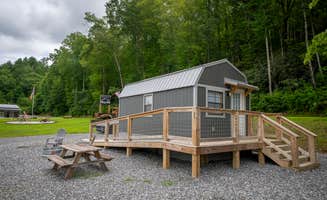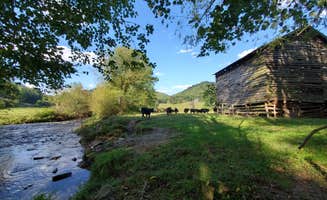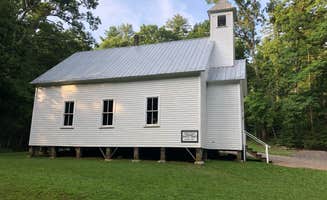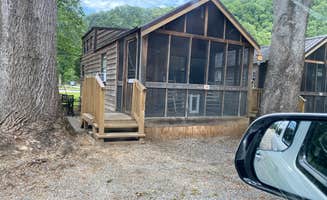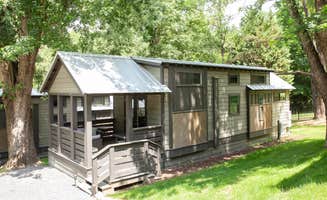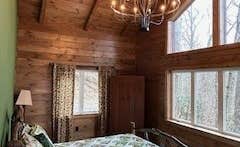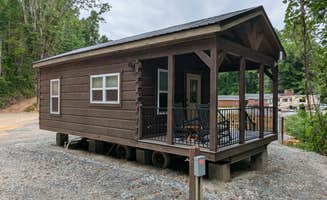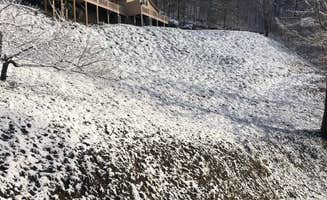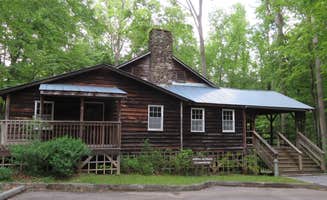Cabin accommodations near Croatan National Forest include rustic facilities along the Nantahala River and modern options in nearby Townsend, Tennessee. Most locations lie within forested settings at elevations between 800-1200 feet, experiencing mild winters and humid summers. Seasonal considerations affect water access, with some cabins closing during winter months while others maintain year-round operations with adjusted fees.
What to do
River activities: Splash, wade and tube near riverfront cabins. At Little River Campground & RV Resort, riverside cabin sites include access to water recreation. "You can swim, play, tube, etc. in the river at your own risk," notes a visitor who appreciated the convenient water access. Cabin guests can enjoy the mountain waters during summer months.
Motorcycle touring: Access mountain roads from cabin bases. Several cabin locations serve as starting points for riders exploring regional scenic routes. "Great location and the Dragon!" remarks a rider who stayed at Simple Life Mountain Retreat & Campground. This motorcyclist-oriented property offers cabins specifically positioned for road access to popular mountain routes.
Ghost town exploration: Visit nearby abandoned structures. Historic buildings and former vacation homes create opportunities for cultural exploration. "One of the more intriguing areas to explore is the Daisy Town ghost town," explains a camper who investigated the abandoned cabins near Elkmont Campground. Guests can walk through some open structures while others undergo renovation.
What campers like
Privacy levels: Secluded options at premium sites. Campgrounds offer varying degrees of seclusion at their cabin accommodations. "The site was somewhat larger and more secluded," notes a visitor to Elkmont who preferred certain cabin locations. Site selection significantly impacts the privacy experience, with riverfront spots typically commanding premium rates.
Bathroom accessibility: Options ranging from shared to private facilities. Mountaineer Campground maintains separate family bathrooms beyond standard facilities. "I really liked that they have a family restroom that is separate from the regular men's and women's bathroom," explains a guest who valued this feature. Bathroom cleanliness varies substantially between properties.
Kitchen provisions: Bring your own cooking equipment. Most cabin rentals require guests to supply cooking gear beyond basic appliances. "Glad I brought my own grate for campfire cooking," mentions a Simple Life Mountain Retreat visitor who planned ahead. Outside grills and fire rings serve as primary cooking areas at more rustic accommodations.
What you should know
Booking timing: Reserve well in advance for peak seasons. Popular cabin accommodations fill quickly, particularly during autumn leaf viewing periods and summer holidays. "Make your reservations far in advance this is a destination!" advises a visitor to Cades Cove Campground, highlighting the competitive reservation process.
Off-grid considerations: Prepare for limited connectivity. Cell service varies significantly across mountain cabin locations. "No cell service for Verizon and none for many miles on the drive to the site," reports a Cades Cove visitor. Properties with more amenities may offer limited WiFi access in common areas, but cabin interiors typically lack reliable connections.
Temperature management: Cabin climate control varies widely. Heat and cooling systems differ substantially between properties. "Cabins have heat and air," confirms a Simple Life visitor, while more primitive accommodations like Donley Cabin provide no climate regulation. Pack appropriate bedding for seasonal temperature fluctuations.
Tips for camping with families
Electronic detox: Prepare children for limited device usage. The lack of electrical outlets and connectivity creates opportunities for family interaction. "Nobody wanted to go because no electronics, no electricity, no running water. We had to drag the kids the first time," shares a Donley Cabin visitor whose perspective changed dramatically after their stay.
Activity planning: Schedule organized recreation. Some campgrounds offer structured children's activities during peak seasons. "They had crafts and hayrides while we were here," notes a Little River Campground guest who appreciated the family programming. Morning craft sessions typically run 1-2 hours during summer months.
Site selection: Request locations away from common areas. Cabin placement significantly impacts noise exposure. "Neighbors will be close but pull through was easy," explains a Little River Campground visitor who found acceptable privacy despite the campground's compact layout. Request sites away from playgrounds for quieter evening conditions.
Tips from RVers
Electrical requirements: Confirm amperage before booking. Cabin locations with RV access typically offer various electrical options. "Our site had 30amp, water, sewer and cable," explains a Little River Campground guest who appreciated the comprehensive hookups. More rustic properties like Nantahala Hideaway Campground & Cabins maintain limited electrical availability, particularly at primitive cabin sites.
Site leveling: Bring blocks for uneven terrain. Mountain cabin locations often feature sloped parking surfaces. "Only surprise was unlovely site, our neighbor had to loan blocks to set camper," reports a visitor to Little Arrow Outdoor Resort who arrived unprepared for the terrain. Cabin occupants who bring campers should pack leveling equipment.
Access limitations: Research road conditions before arrival. Mountain roads leading to cabin facilities present challenges for larger vehicles. "Long and windy road to get to the area," notes a Cades Cove visitor who found access time-consuming. Cabin occupants traveling with trailers should research turning radius limitations at their chosen destination.



